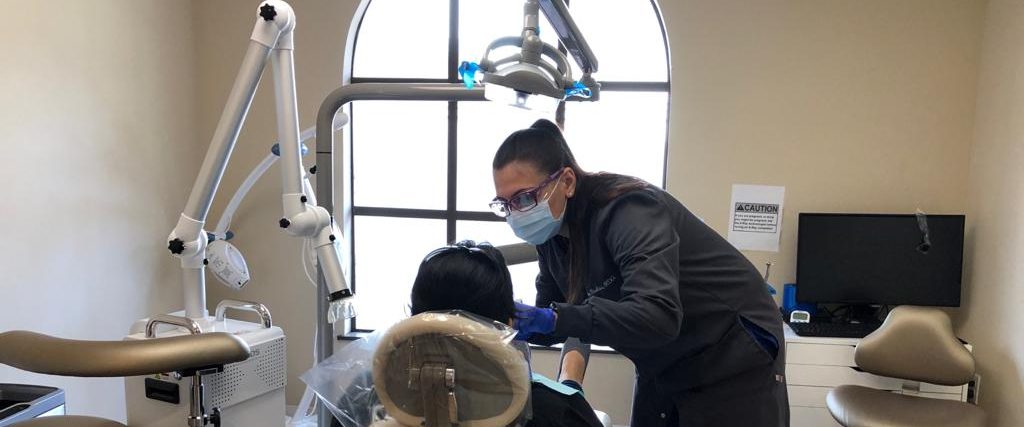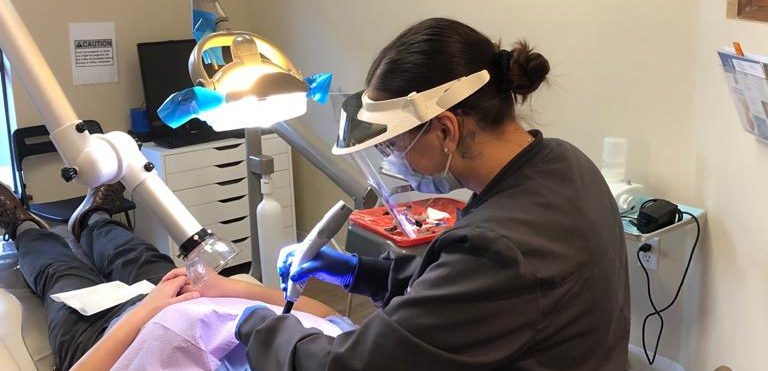Date : 10/06/2020
If you've endured the loss of teeth due to gum disease, tooth decay, or even an injury, then you might be one of the many people considering dental implants. It used to be the only way to treat missing teeth was with dentures or bridges. But luckily, specialists have made some amazing advancements in dental appliances and tooth replacement. Now, you even have multiple types of dental implants to choose from, depending on what works best with your mouth and your budget.
The range of the types of dental implants available can seem pretty overwhelming. While your dentist is your best source for recommendations, you should become informed on your own as to which kinds are available.
By educating yourself, you'll know which questions to ask your dentist. You may even find yourself advocating for ones that your dentist might not be familiar with.
Let's take a look at all the options!
What Are Dental Implants?
Dental implants replace the tooth roots of missing teeth. Along with looking better, it's essential to have some sort of replacement. It ensures that you'll be able to eat and speak normally after the loss of a tooth or multiple teeth.
In fact, they also help to stop or prevent bone loss. Your dental implants then provide a foundation for either permanent or removable replacement teeth. The lab will make these to match your natural teeth in both how they feel and how they look.
When And Why Do You Need Dental Implants?
Your dentist may recommend and use dental implants in a number of situations where there has been the loss of a single tooth, multiple teeth, or a full set of teeth. Dentists often categorize the use of this type of procedure as a form of prosthetic dentistry.
However, you can also consider as a form of cosmetic dentistry.
Those who have lost one or more teeth may feel too self-conscious to smile or talk very often. Also, the loss of teeth can cause bite irregularities. That can lead to negative eating habits and secondary health problems such as malnutrition.
Sometimes, tooth loss can cause an aversion to certain foods. Malnutrition can be particularly a problem with senior citizens, who may already suffer from poor nutrition.
When you replace the tooth roots with the implants, people regain their ability to eat all sorts of foods without pain or struggle to chew. The implants also help to stimulate and maintain the jaw bone, preventing further loss. This ultimately aids in supporting the natural shape of your facial features, as well.
Materials Used To Make Dental Implants
Manufacturers make dental implants from titanium. It's a bio-compatible material. So, it's safe to have in your mouth and serves as an ideal metal for fusing with your gum and bone tissues.
Once surgically inserted, your dental implants fuse with your natural gum and bone tissues. So, this creates a strong foundation for your prosthetic teeth.
Recorded success rates log as high as up to 98 percent, although this may vary depending on the health and age of the patient. This variance also occurs primarily due to where the dentist placed the implants on the jaw.
Another factor is the amount of proper care that you give to your implants. If you maintain them properly, they'll last you a lifetime.
Leaving Original Teeth Intact
Many dentists and patients prefer dental implants because they don't require any alteration of the remaining teeth. In contrast, many bridges require that the dentist reduce or changing the size of your existing teeth. In this way, dental implants support your overall oral health by only replacing the teeth that need it.
Types Of Dental Implants
If dental implants seem like something you would be interested in, then you should know that you'll run across two main types of dental implants. You should know a bit about both types of dental implants and when your dentist will most likely recommend them.
Single-stage VS Two-stage
Dentists break dental implants down into either single-stage implants or two-stage implants.
The single stage implants involve a long implant that is put into the jaw bone, with the top part level with the gum tissue. The gum tissue is stitched up, leaving the implant head visible. After you've had several months to heal, your dentist can attach the restoration without the need for further surgery to expose the head.
Two-stage implants are slightly different. The rod isn't quite as long. So, when the dentist stitches up the gum tissue, it covers the implant. Several months after healing, your dentist will perform minor surgery to access the implant and attach the restoration.
Endosteal Dental Implants
Endosteal implants are one of the most common types of dental implants. Your dentist places this type directly into your jawbone by way of the tooth root. These implants resemble screws, cylinders, or plates. The dentist will decide which types of dental implants to use based on your needs and the space available.
Subperiosteal Implants
Subperiosteal implants are less common types of dental implants. Your dentist places these under the gumline but above the jawbone. Your dentist will use this type of implant in situations where the patient has suffered from jawbone density loss.
They may decide to use them in any other case where placing the implants directly into the jawbone won't be possible or practical.
The size of the implant can vary, as well. For those who have insufficient gum tissue, the dentist might choose mini, narrow, or shorter implants. They'll also use these if the patient can't withstand traditional implants for some reason.
Making Jawbones A Better Host For Implants
Sometimes, the dentist will recommend treatments that will make their patient's jawbones a better place for all types of dental implants.
The first option is bone augmentation. Augmentation involves regenerating the bone in the patient's jaw through the use of bone additives and growth factors that fortify the bone.
Another option is a sinus lift. This procedure adds bone below the sinus cavities. The dentist uses this method in cases where the natural bone has deteriorated due to the missing teeth.
Lastly, the dentist might give the patient a ridge expansion. Here, a bone graft is added along the top of the jaw to fortify it and make it more suitable for all types of dental implants.
Alternative Treatment Options
If you're still not sold on the idea of traditional dental implants or don't have a sufficiently healthy jaw bone, there are some other options you can choose.
Immediate Load Dental Implants
Instead of making multiple appointments and visits with your dentist, you can get temporary teeth placed the same day you get your implants. Also called "Teeth In a Day," this option works well if you have enough natural bone.
With an adequately secure implant, your jaw can provide immediate support for placement as well as pressure on the new temporary tooth.
Mini Dental Implants
Some dentists call these narrow diameter implants. This toothpick-sized implant is narrower than most common dental implants. Your dentist can place these in your mouth with less-invasive techniques. And they're typically used for stabilizing a lower denture.
All-on-4
Your dentist can use this technique as an alternative to placing a set of replacement teeth on the top or bottom. (This is known as a full arch.)
Your dentist places four dental implants in the available bone, avoiding the need for any bone grafting. They can set your temporary teeth on the same day. You'll have to follow a modified diet while the gum tissues heal and the implants bond with your jawbone.
Then, after six months, your dentist replaces your temporary teeth with your permanent, customized teeth. At that point, you can resume a regular diet.
Bridges
For those who don't wish to have dental implants, bridges might prove a better alternative.
Dentists refer to one type of bridge as the tooth-supported fix bridge. This bridge will help to fix a single tooth. This option involves grinding away (and potentially damaging) the healthy adjacent teeth used to support the bridge.
This type of bridge doesn't stimulate bone growth beneath it, so the bone may deteriorate over time. Bridges can fail after 5 to 10 years because these areas are hard to floss, making the surfaces below susceptible to decay.
Another type of bridge is called a resin-bonded bridge. Also referred to as a Maryland Bridge, dentists use this type of bridge for replacing the front teeth that don't have the same biting and chewing demands of your back teeth. Wings on each side of the bridge attach to the healthy adjacent teeth.
In that case, however, your dentist won't have to grind them down. Resin-bonded bridges look and function better than removable dentures, but they're still not as strong as fixed bridges. And they don't last as long as your implants do.
Dentures
Some people prefer to use dentures or can't use other methods of teeth replacement. The first option here is a partial denture. Your dentist won't have to grind down any of your nearby teeth.
However, they're not as comfortable or as stable as dental implants. Partial dentures can also affect your speech as well as your ability to eat normally.
Dentures are less expensive, but this type of restoration doesn't look as natural as some of the other options. The bone underneath a removable denture can also deteriorate over time. That, in turn, changes the look of your smile and can alter the shape of your face.
Another option you may choose to consider is removable complete dentures. These sit on top of the gums where your missing teeth used to be. Many people find full dentures somewhat uncomfortable -- particularly if they don't fit correctly.
Also, they can affect your ability to taste some foods and cause sore gums.
Complete dentures can also shift and move around when you don't want them to. This movement can also cause an embarrassing clicking noise when you're trying to speak or chew.
Dentures can last an average of 7 to 15 years. You need to remove them regularly to clean them thoroughly, which some people consider time-consuming. You'll also have to watch for bone deterioration with full dentures, as well.
Choosing The Right Types Of Dental Implants For You
There are several different types of dental implants. Luckily, this allows your dentist to provide a customized plan that works best for your smile. It also allows you to choose a course of treatment that best fits your budget.
Ultimately, you should talk to your dentist to see what they think would be best for you and the health of your mouth. Here at Your Caring Dentist Group, our professionals are ready to help.




